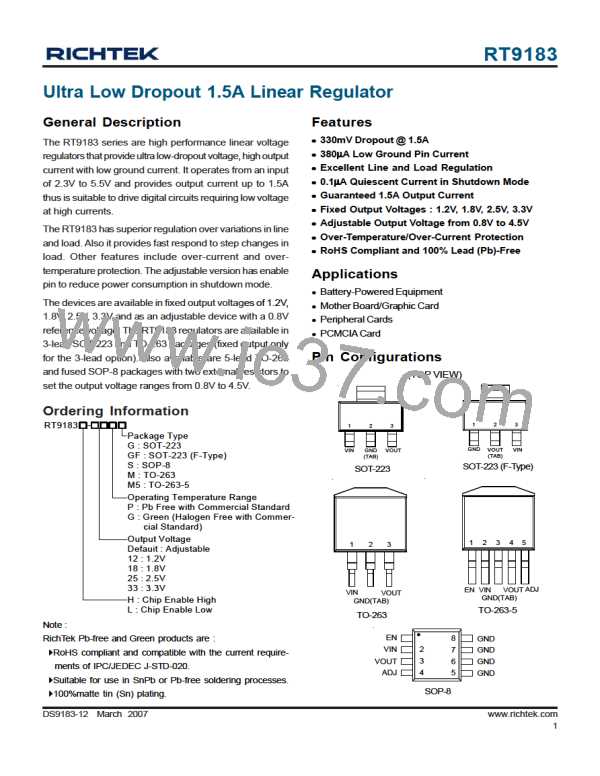RT9183
Equally important to consider is a capacitor's ESR change
with temperature: this is not an issue with ceramics, as
their ESR is extremely low. However, it is very important
in tantalum and aluminum electrolytic capacitors. Both
show increasing ESR at colder temperatures, but the
increase in aluminum electrolytic capacitors is so severe
they may not be feasible for some applications.
The increasing ESR at lower temperatures can cause
oscillations when marginal quality capacitors are used (if
the ESR of the capacitor is near the upper limit of the
stability range at room temperature).
Aluminum:
This capacitor type offers the most capacitance for the
money. The disadvantages are that they are larger in
physical size, not widely available in surface mount, and
have poor AC performance (especially at higher
frequencies) due to higher ESR and ESL.
Ceramic:
For values of capacitance in the 10μF to 100μF range,
ceramics are usually larger and more costly than tantalums
but give superior AC performance for by-passing high
frequency noise because of very low ESR (typically less
than 10mΩ). However, some dielectric types do not have
good capacitance characteristics as a function of voltage
and temperature.
Compared by size, the ESR of an aluminum electrolytic is
higher than either Tantalum or ceramic, and it also varies
greatly with temperature. A typical aluminum electrolytic
can exhibit an ESR increase of as much as 50X when going
from 25°C down to -40°C.
Z5U and Y5V dielectric ceramics have capacitance that
drops severely with applied voltage. Atypical Z5U or Y5V
capacitor can lose 60% of its rated capacitance with half
of the rated voltage applied to it. The Z5U and Y5V also
exhibit a severe temperature effect, losing more than 50%
of nominal capacitance at high and low limits of the
temperature range.
It should also be noted that many aluminum electrolytics
only specify impedance at a frequency of 120Hz, which
indicates they have poor high frequency performance. Only
aluminum electrolytics that have an impedance specified
at a higher frequency (between 20kHz and 100kHz) should
be used for the device. Derating must be applied to the
manufacturer's ESR specification, since it is typically only
valid at room temperature.
X7R and X5R dielectric ceramic capacitors are strongly
recommended if ceramics are used, as they typically
Any applications using aluminum electrolytics should be
thoroughly tested at the lowest ambient operating
temperature where ESR is maximum.
±
maintain a capacitance range within 20% of nominal
over full operating ratings of temperature and voltage. Of
course, they are typically larger and more costly than Z5U/
Y5U types for a given voltage and capacitance.
Thermal Considerations
Thermal protection limits power dissipation in RT9183.
When the operation junction temperature exceeds 170°C,
the OTP circuit starts the thermal shutdown function and
turns the pass element off. The pass element turns on
again after the junction temperature cools by 30°C.
Tantalum:
Solid tantalum capacitors are recommended for use on
the output because their typical ESR is very close to the
ideal value required for loop compensation. They also work
well as input capacitors if selected to meet the ESR
requirements previously listed.
For continuous operation, do not exceed absolute
maximum operation junction temperature 125°C. The
power dissipation definition in device is:
Tantalums also have good temperature stability: a good
quality tantalum will typically show a capacitance value
that varies less than 10~15% across the full temperature
range of 125°C to -40°C. ESR will vary only about 2X going
from the high to low temperature limits.
PD = (VIN − VOUT) x IOUT + VIN x IQ
www.richtek.com
10
DS9183-12 March 2007

 RICHTEK [ RICHTEK TECHNOLOGY CORPORATION ]
RICHTEK [ RICHTEK TECHNOLOGY CORPORATION ]